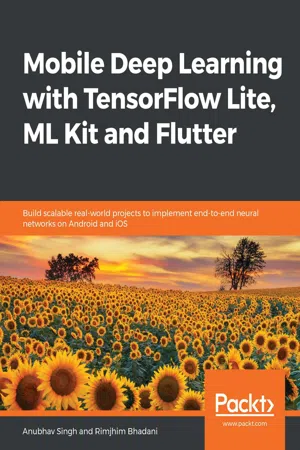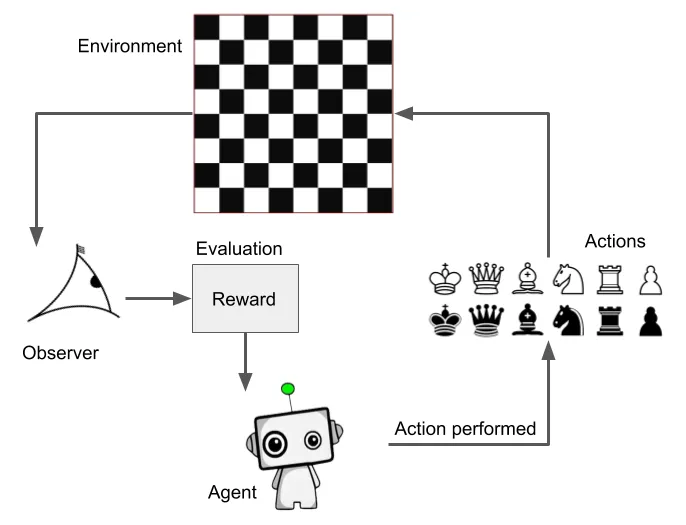
Mobile Deep Learning with TensorFlow Lite, ML Kit and Flutter
Build scalable real-world projects to implement end-to-end neural networks on Android and iOS
Anubhav Singh, Rimjhim Bhadani
- 380 páginas
- English
- ePUB (apto para móviles)
- Disponible en iOS y Android
Mobile Deep Learning with TensorFlow Lite, ML Kit and Flutter
Build scalable real-world projects to implement end-to-end neural networks on Android and iOS
Anubhav Singh, Rimjhim Bhadani
Información del libro
Learn how to deploy effective deep learning solutions on cross-platform applications built using TensorFlow Lite, ML Kit, and Flutter
Key Features
- Work through projects covering mobile vision, style transfer, speech processing, and multimedia processing
- Cover interesting deep learning solutions for mobile
- Build your confidence in training models, performance tuning, memory optimization, and neural network deployment through every project
Book Description
Deep learning is rapidly becoming the most popular topic in the mobile app industry. This book introduces trending deep learning concepts and their use cases with an industrial and application-focused approach. You will cover a range of projects covering tasks such as mobile vision, facial recognition, smart artificial intelligence assistant, augmented reality, and more.
With the help of eight projects, you will learn how to integrate deep learning processes into mobile platforms, iOS, and Android. This will help you to transform deep learning features into robust mobile apps efficiently. You'll get hands-on experience of selecting the right deep learning architectures and optimizing mobile deep learning models while following an application oriented-approach to deep learning on native mobile apps. We will later cover various pre-trained and custom-built deep learning model-based APIs such as machine learning (ML) Kit through Firebase. Further on, the book will take you through examples of creating custom deep learning models with TensorFlow Lite. Each project will demonstrate how to integrate deep learning libraries into your mobile apps, right from preparing the model through to deployment.
By the end of this book, you'll have mastered the skills to build and deploy deep learning mobile applications on both iOS and Android.
What you will learn
- Create your own customized chatbot by extending the functionality of Google Assistant
- Improve learning accuracy with the help of features available on mobile devices
- Perform visual recognition tasks using image processing
- Use augmented reality to generate captions for a camera feed
- Authenticate users and create a mechanism to identify rare and suspicious user interactions
- Develop a chess engine based on deep reinforcement learning
- Explore the concepts and methods involved in rolling out production-ready deep learning iOS and Android applications
Who this book is for
This book is for data scientists, deep learning and computer vision engineers, and natural language processing (NLP) engineers who want to build smart mobile apps using deep learning methods. You will also find this book useful if you want to improve your mobile app's user interface (UI) by harnessing the potential of deep learning. Basic knowledge of neural networks and coding experience in Python will be beneficial to get started with this book.
Preguntas frecuentes
Información
Reinforced Neural Network-Based Chess Engine
- Introduction to reinforcement learning
- Reinforcement learning in mobile games
- Exploring Google's DeepMind
- Alpha Zero-like AI for Connect 4
- Underlying project architecture
- Developing a GCP-hosted REST API for the chess engine
- Creating a simple chess UI on Android
- Integrating the chess engine API with a UI
Introduction to reinforcement learning
- Agent: A virtual entity that performs actions. It is the entity that replaces the designated user of the game/software.
- Action (a): The possible actions that the agent can perform.
- Environment (e): A set of scenarios available in the software/game.
- State (S): A collection of all scenarios, along with the configurations available in them.
- Reward (R): A value that's returned for any action that's performed by the agent, which the agent then tries to maximize.
- Policy (π): The strategy that the agent uses to determine which actions have to be performed next.
- Value (V): R is a short-term per-action reward, whereas value is the total reward expected at the end of a set of actions. Vπ(s) defines the expected total reward by following policy π under the state, S.

Reinforcement learning in mobile games
Exploring Google's DeepMind
AlphaGo
Índice
- Title Page
- Copyright and Credits
- About Packt
- Contributors
- Preface
- Introduction to Deep Learning for Mobile
- Mobile Vision - Face Detection Using On-Device Models
- Chatbot Using Actions on Google
- Recognizing Plant Species
- Generating Live Captions from a Camera Feed
- Building an Artificial Intelligence Authentication System
- Speech/Multimedia Processing - Generating Music Using AI
- Reinforced Neural Network-Based Chess Engine
- Building an Image Super-Resolution Application
- Road Ahead
- Appendix
- Other Books You May Enjoy